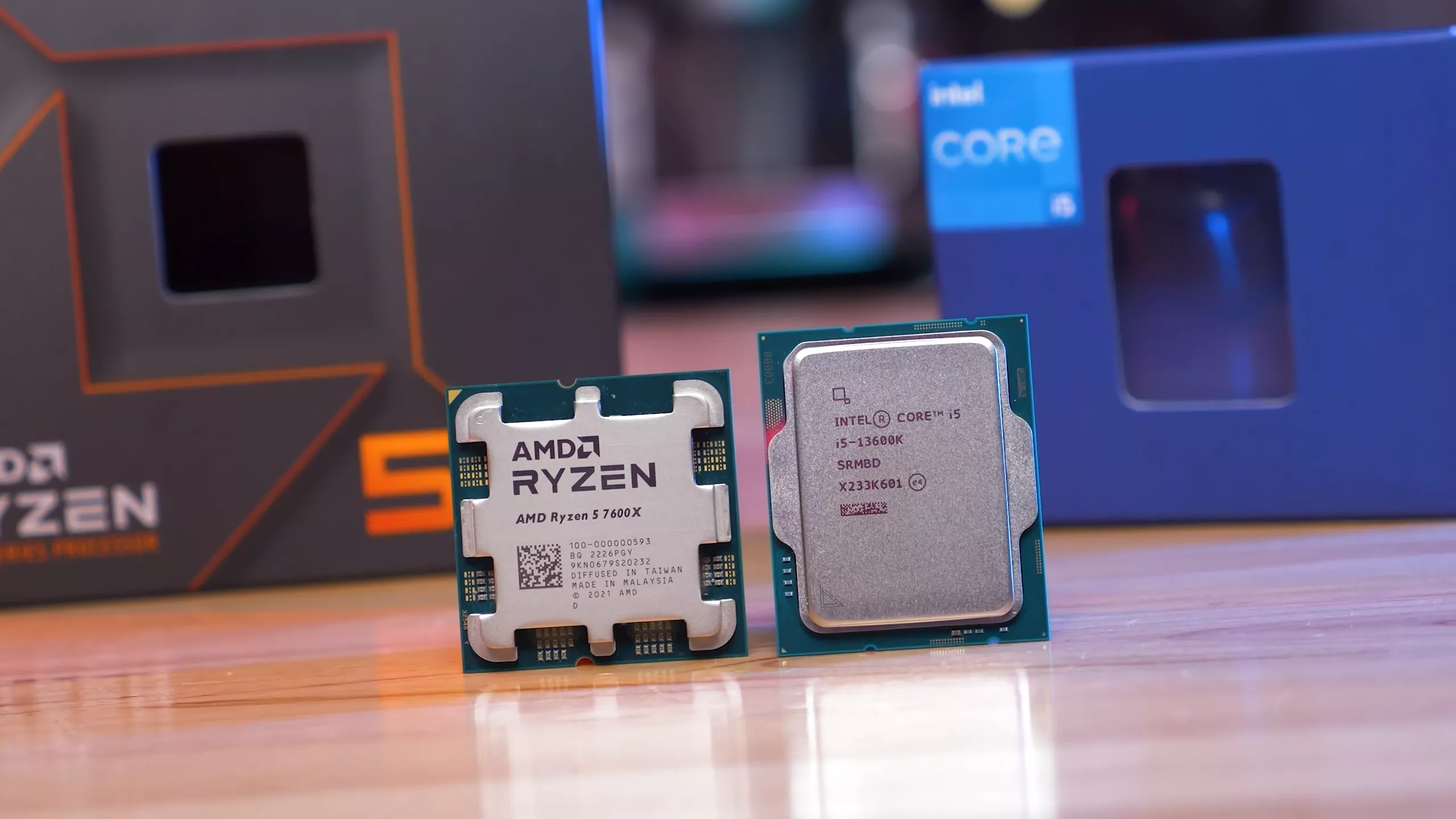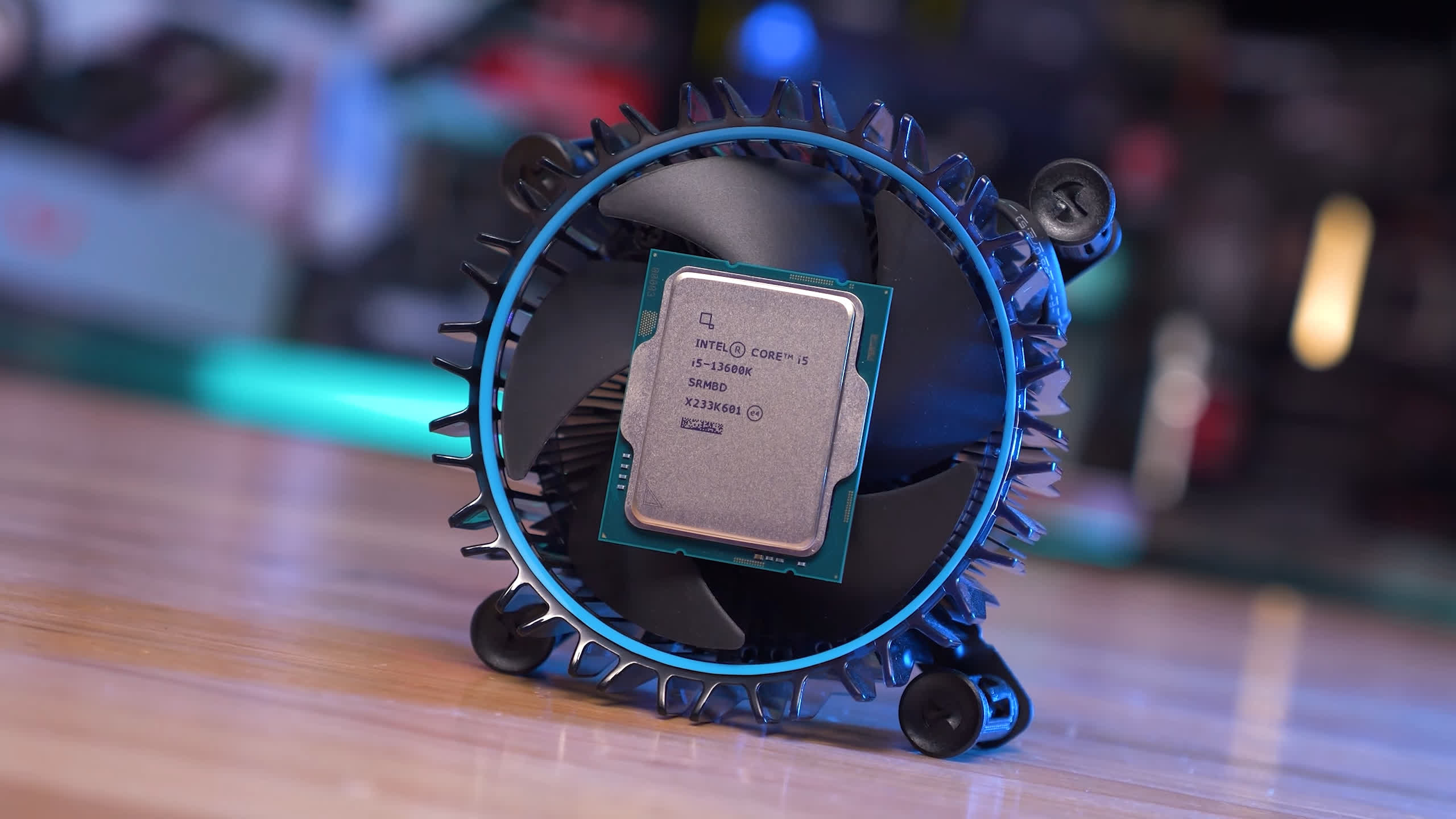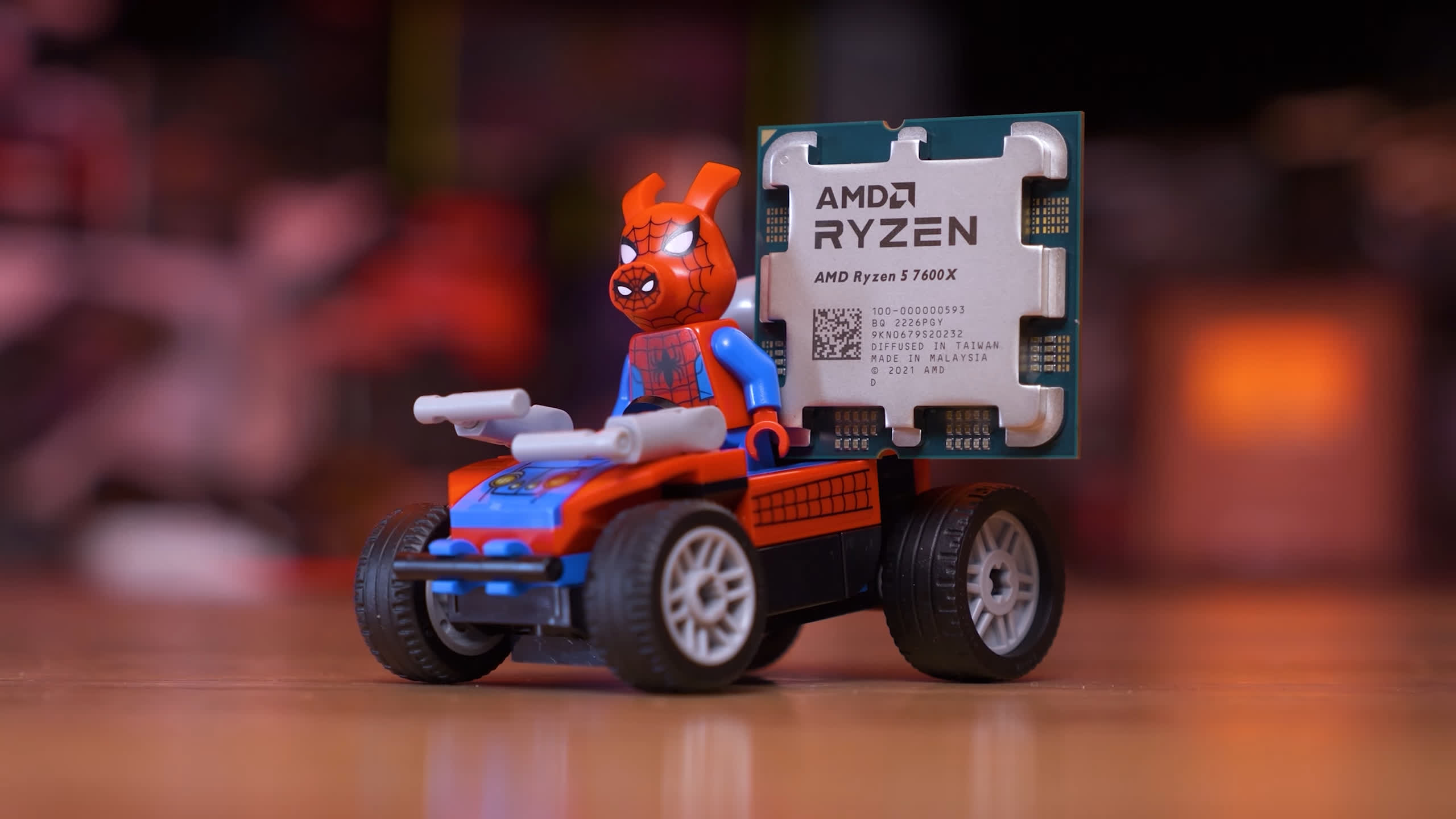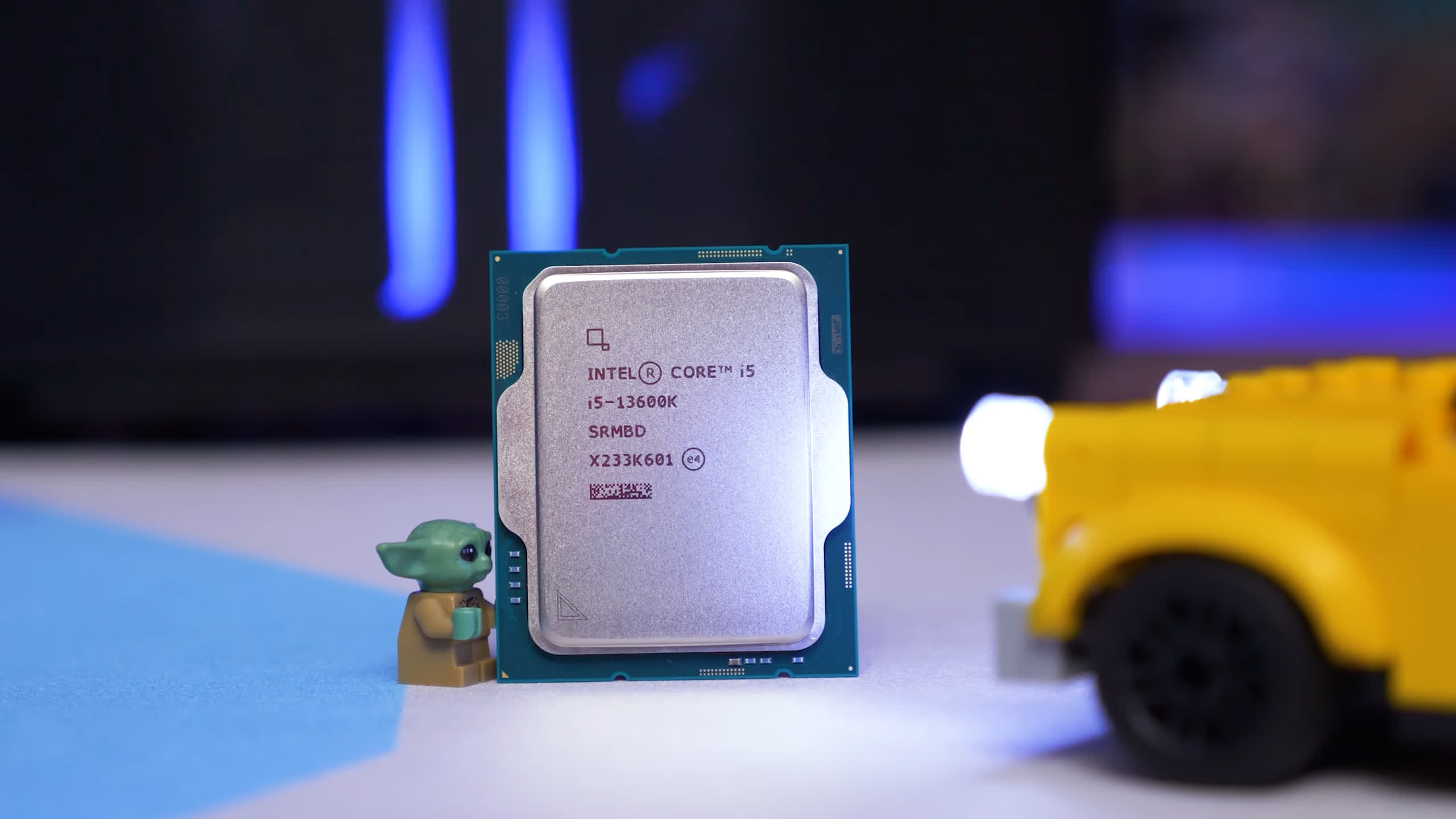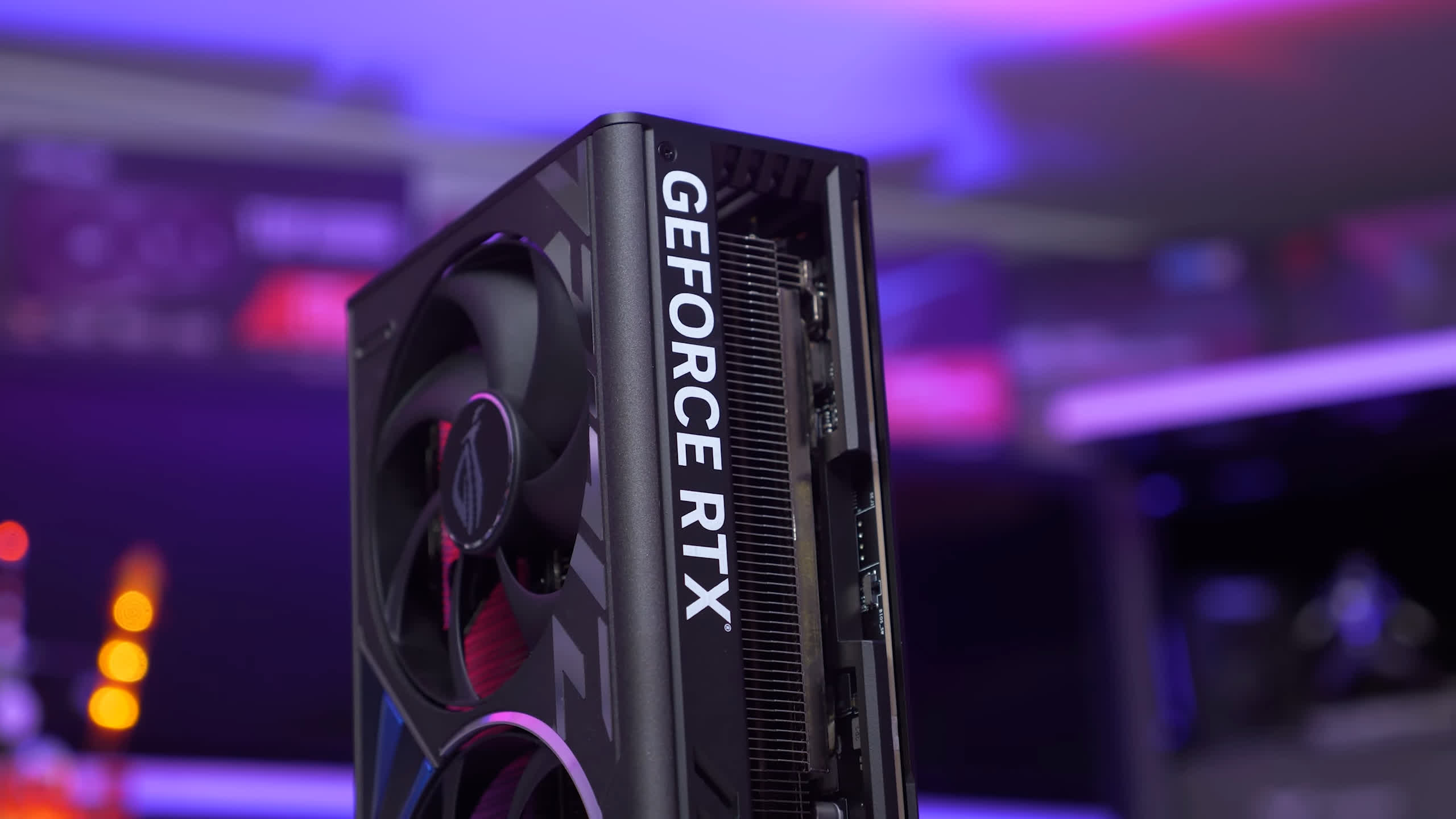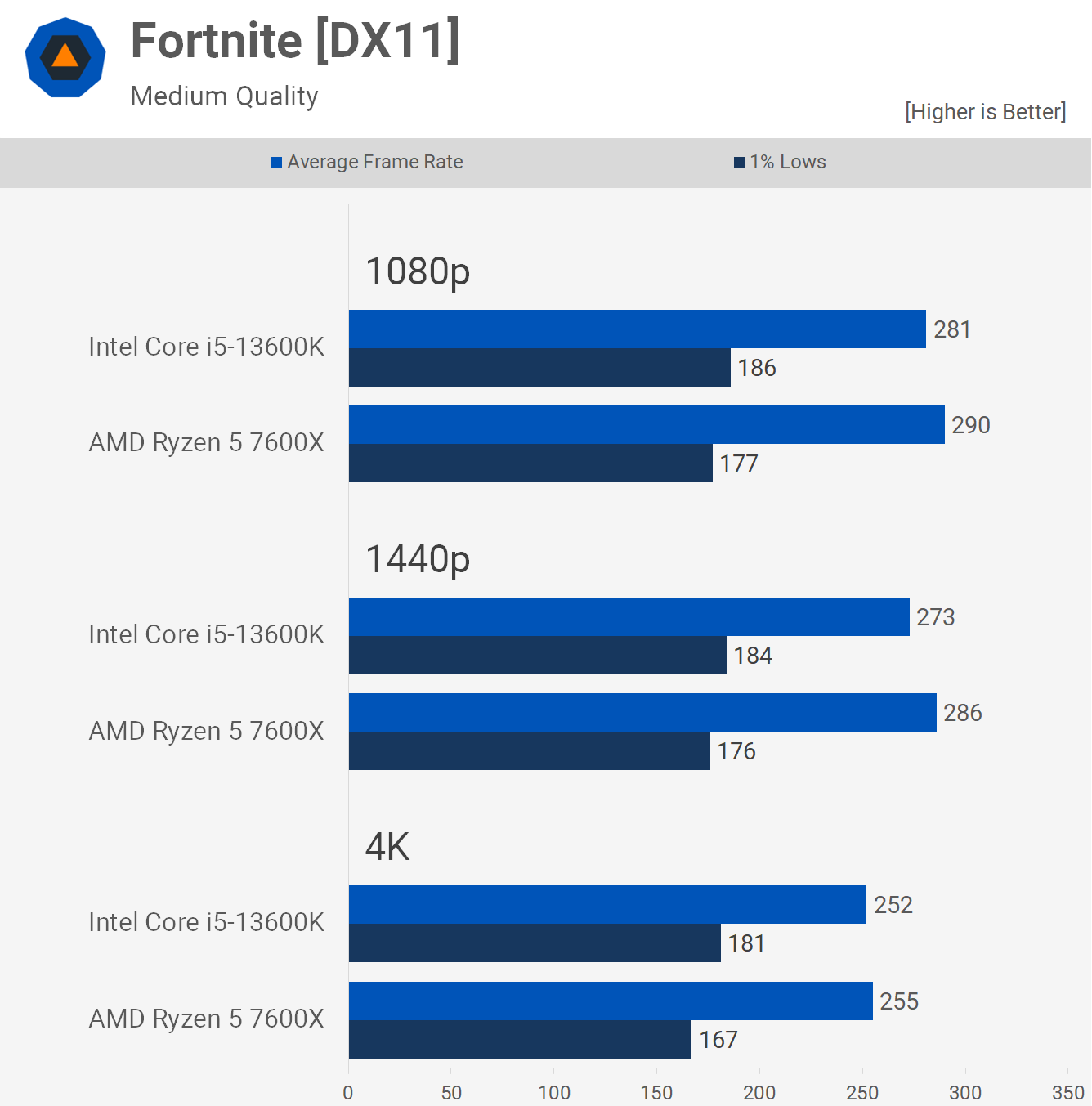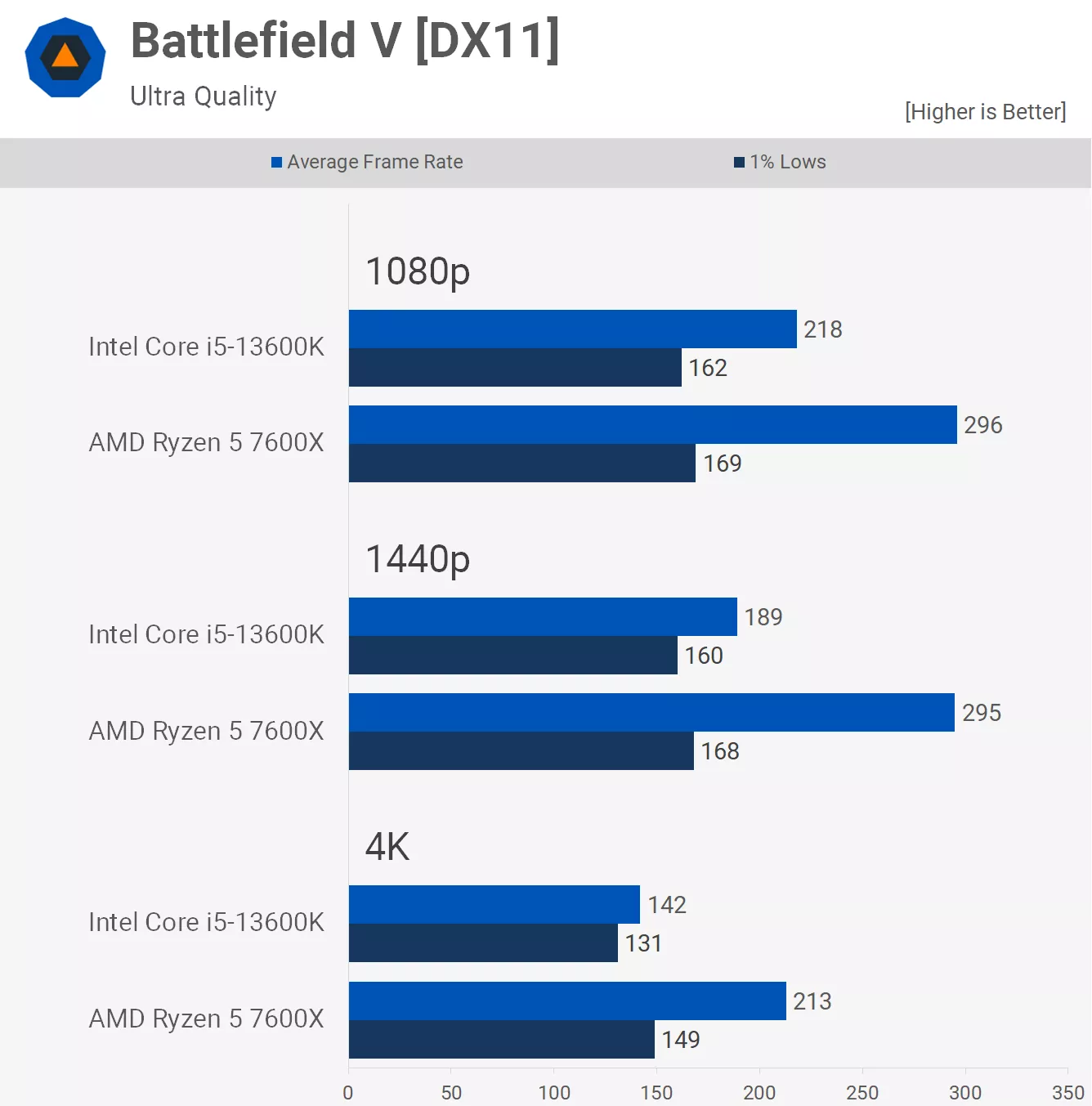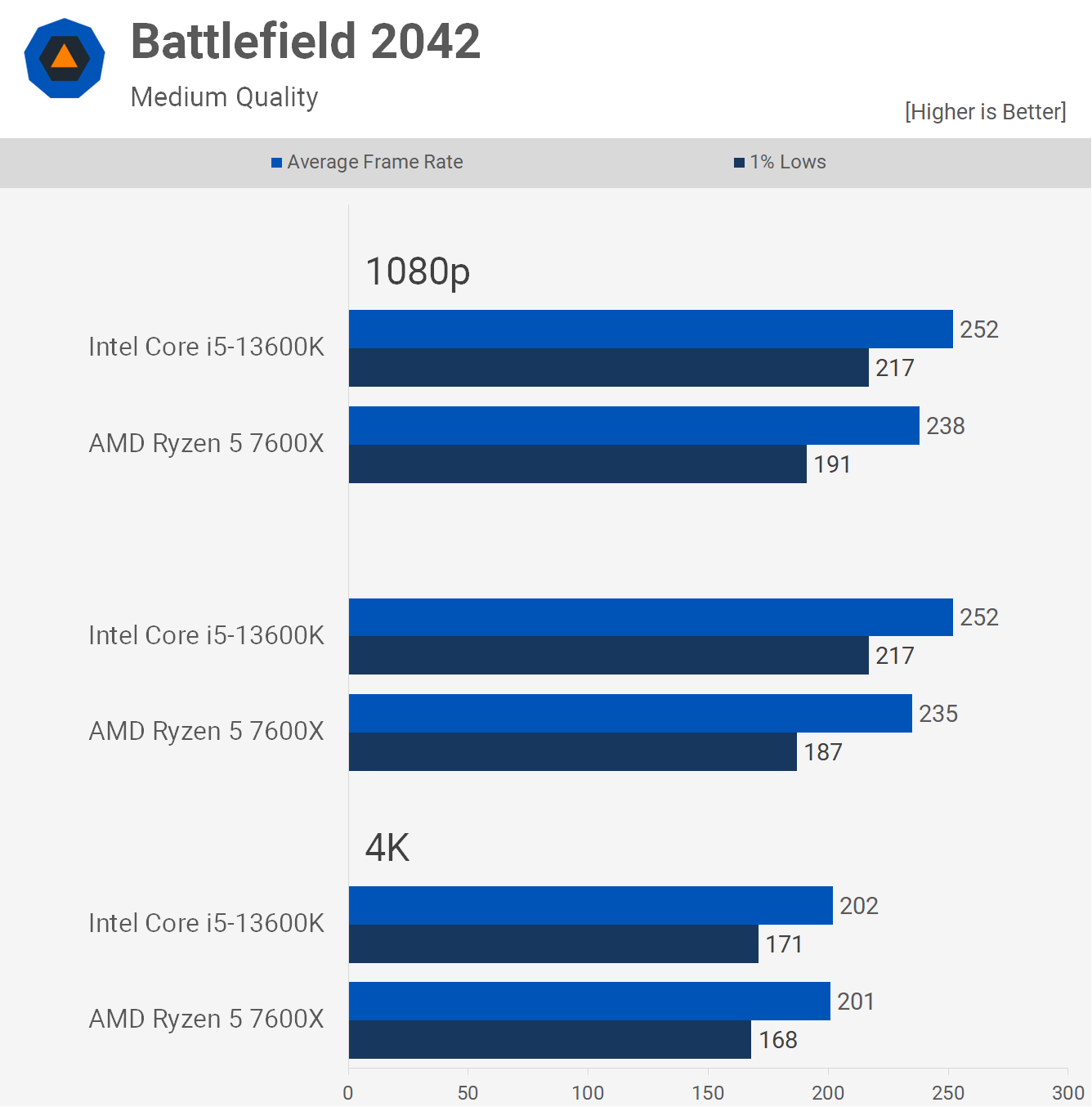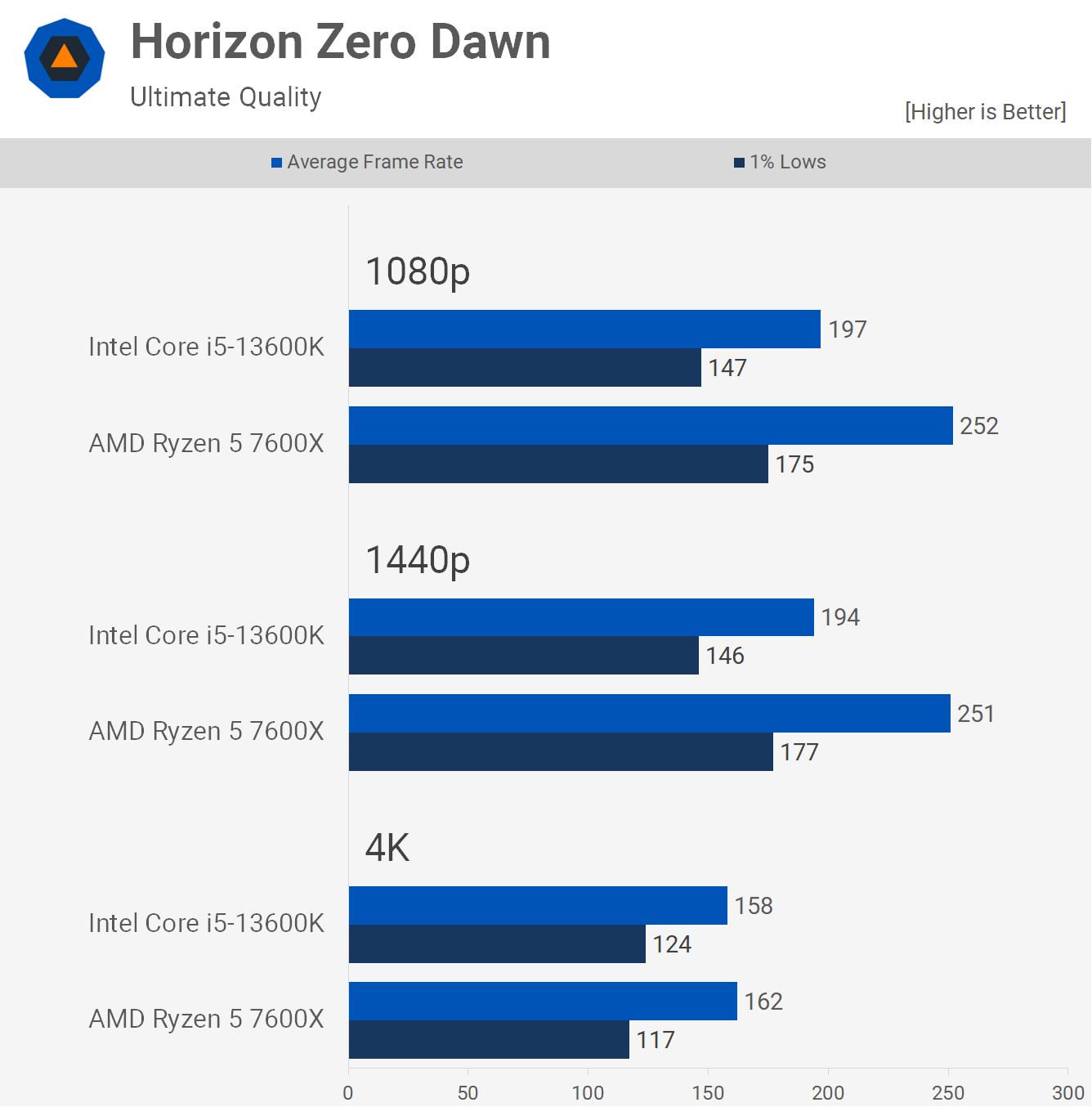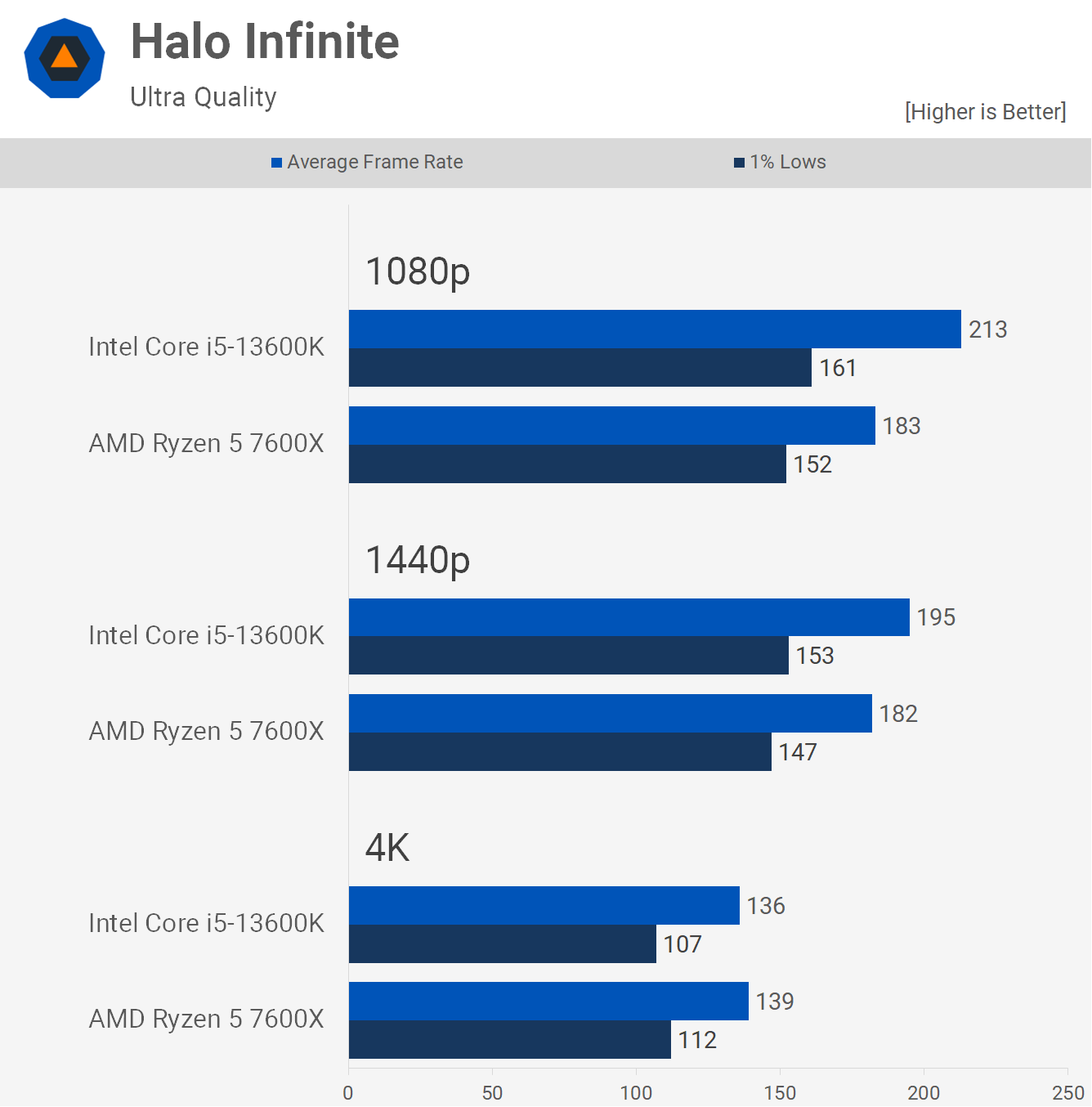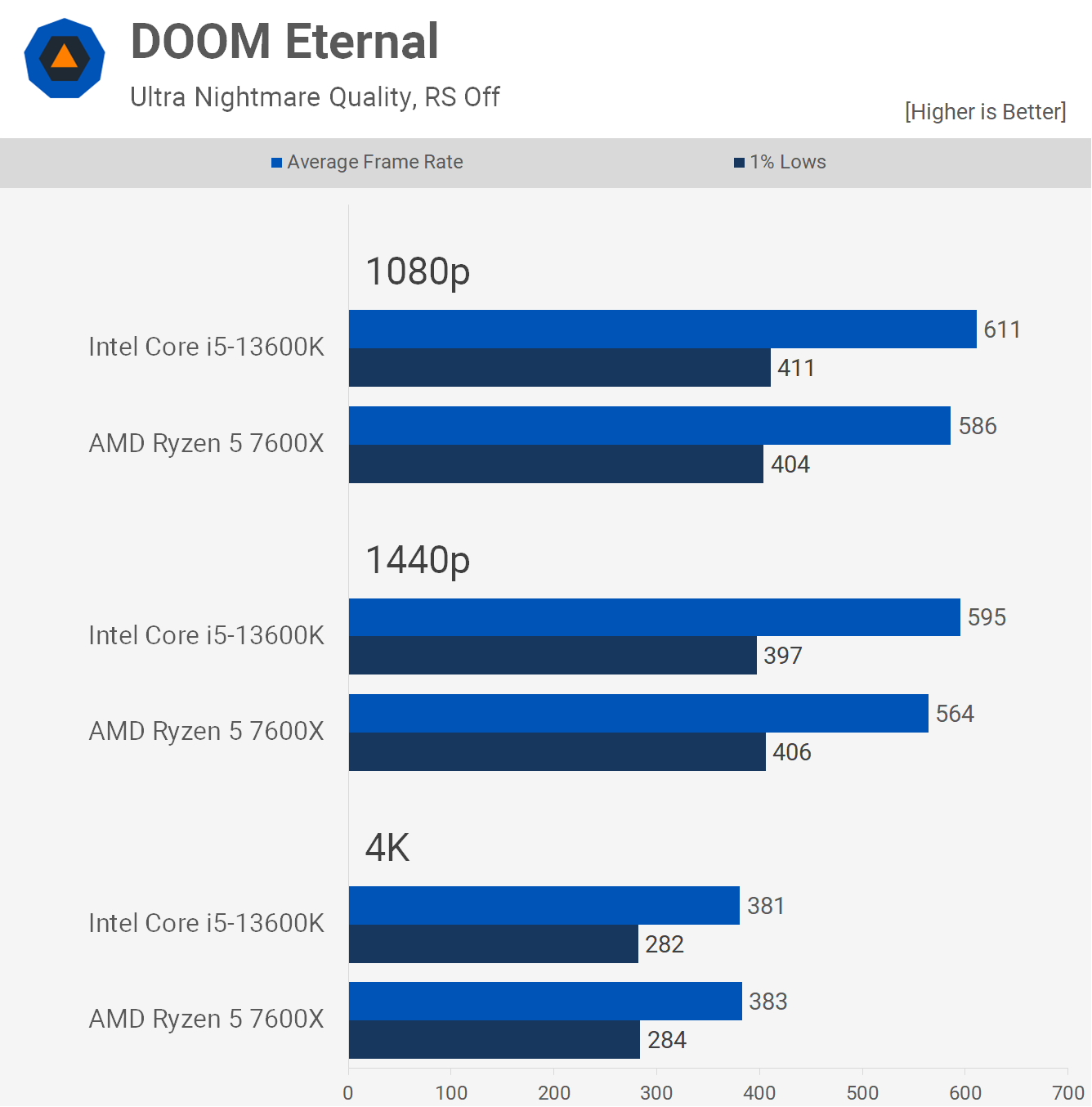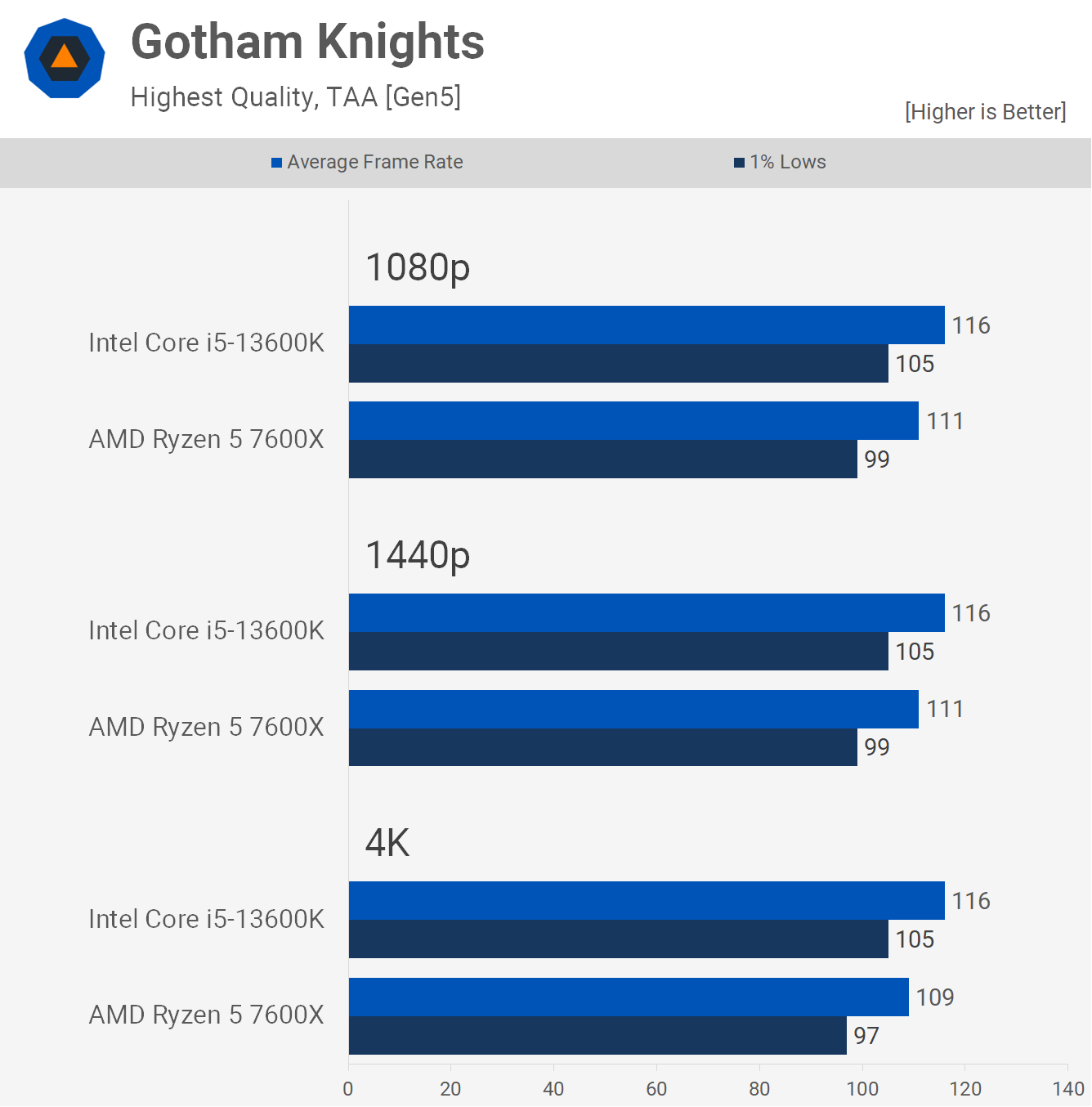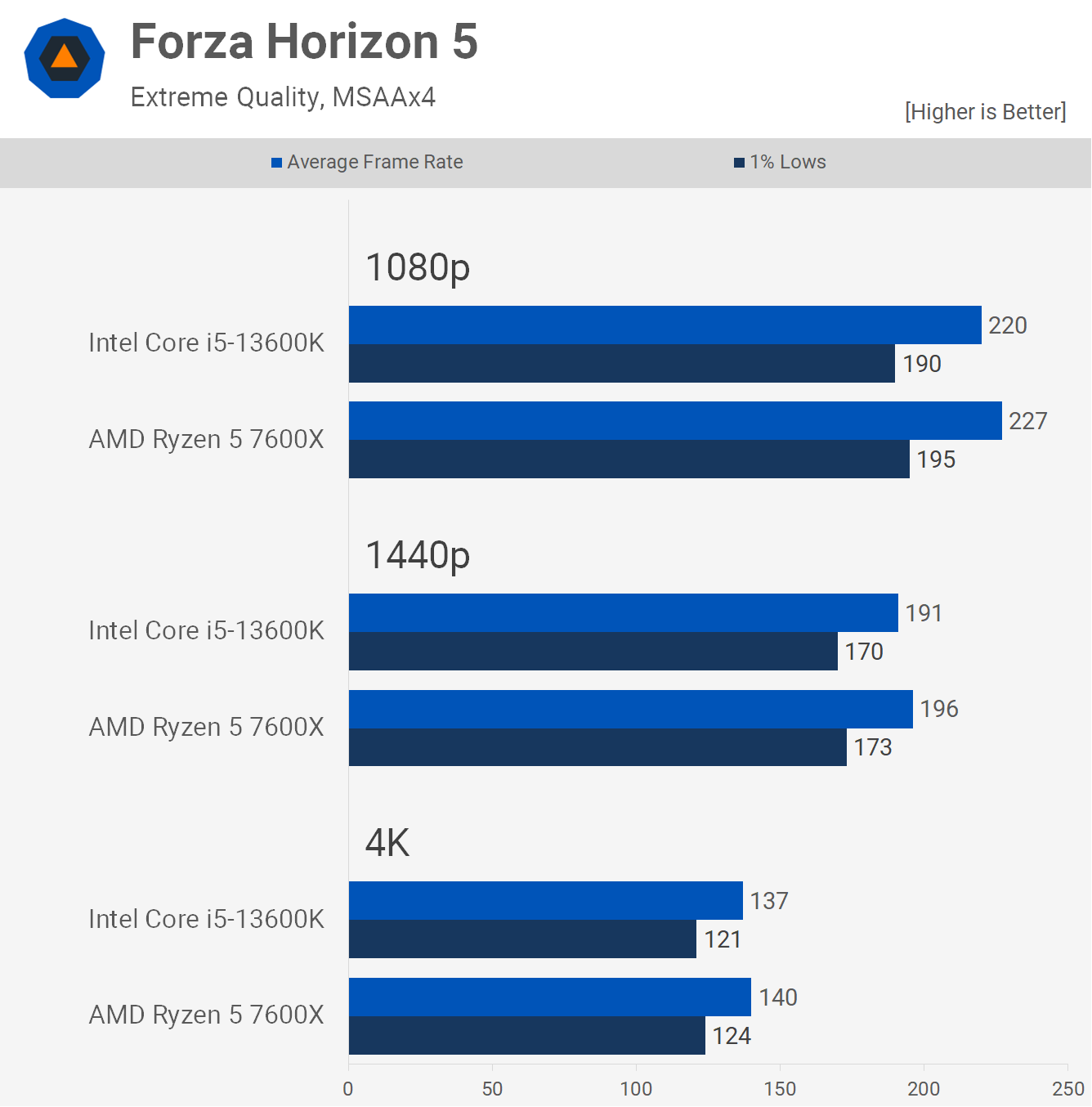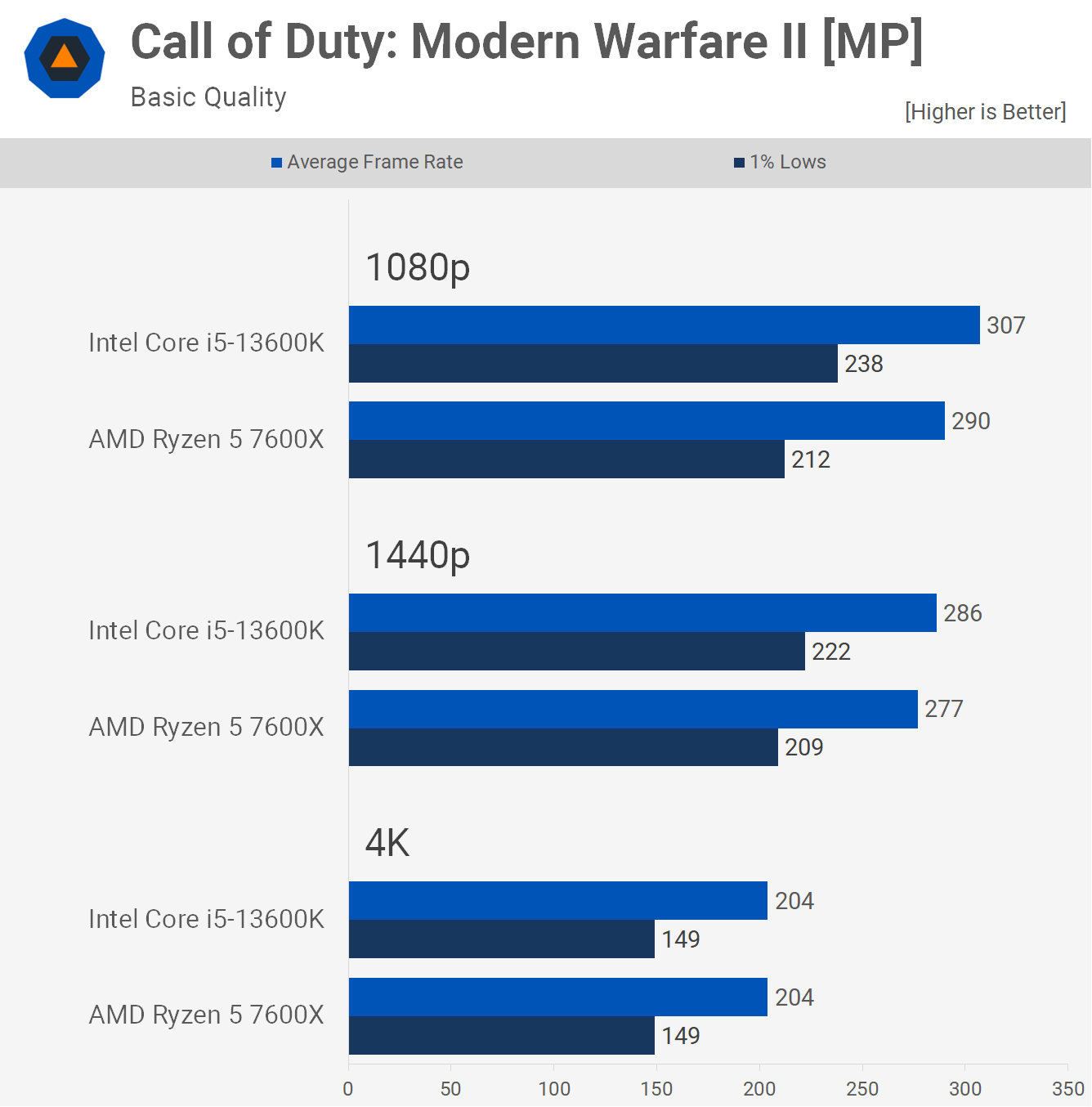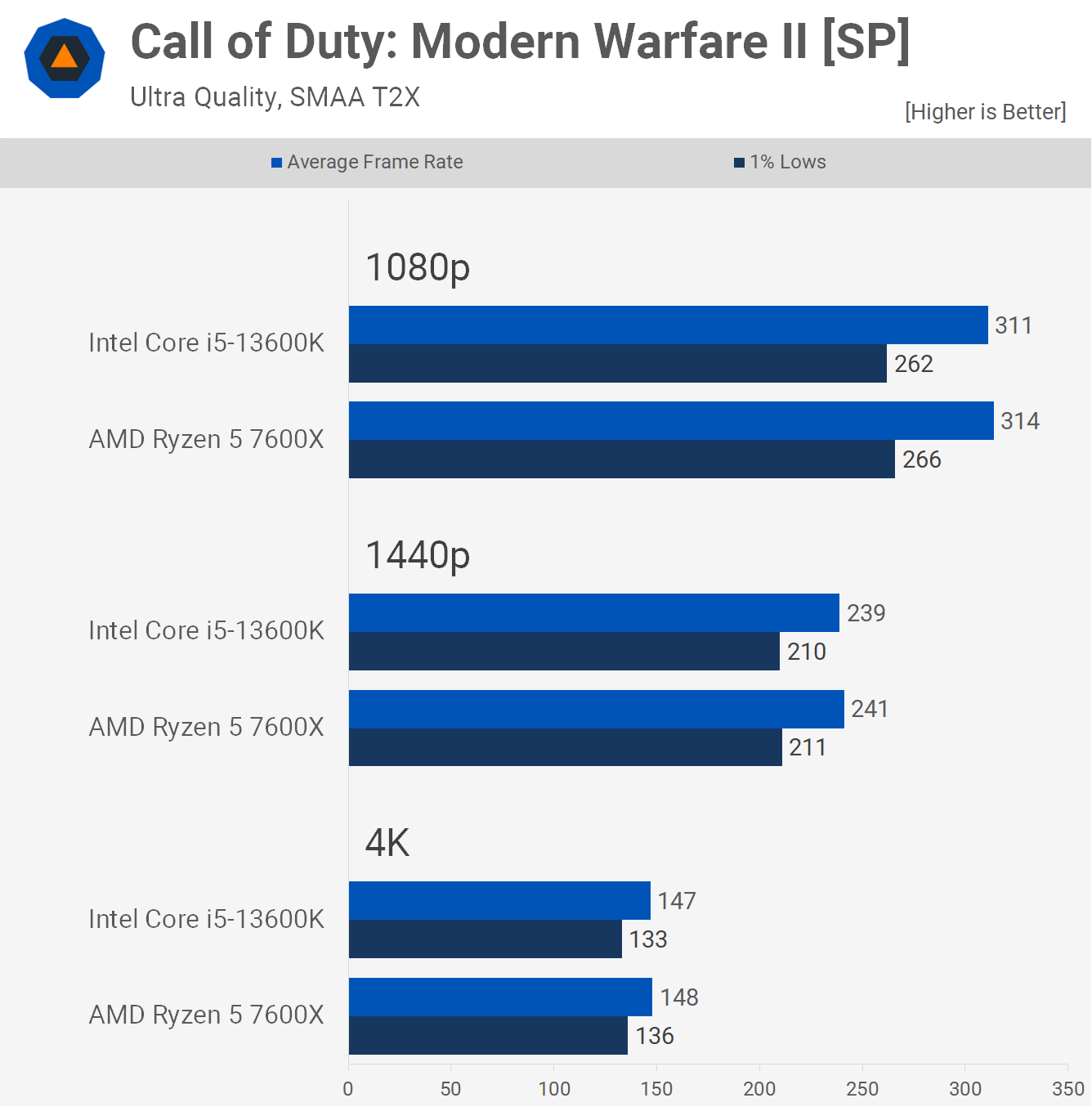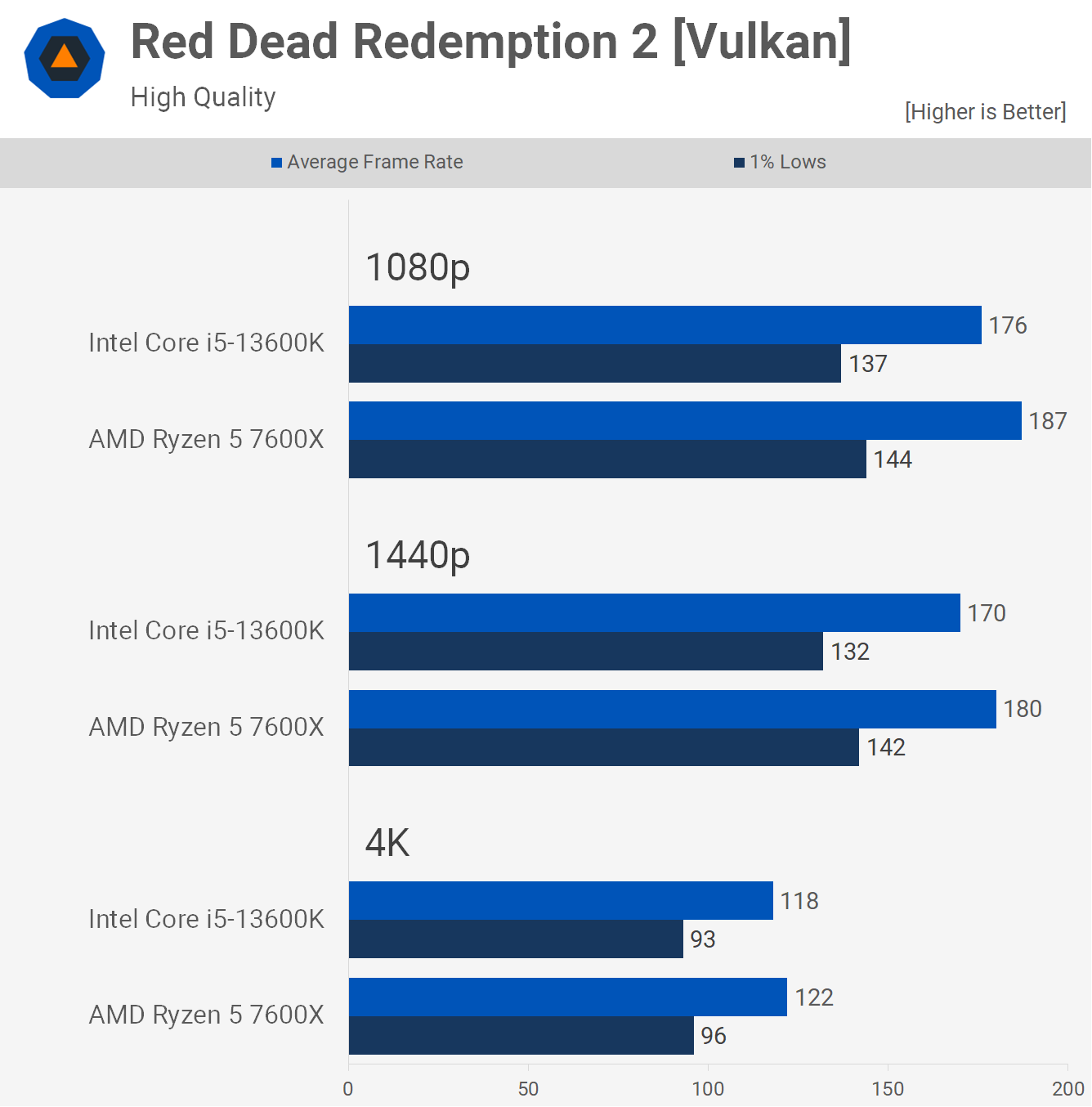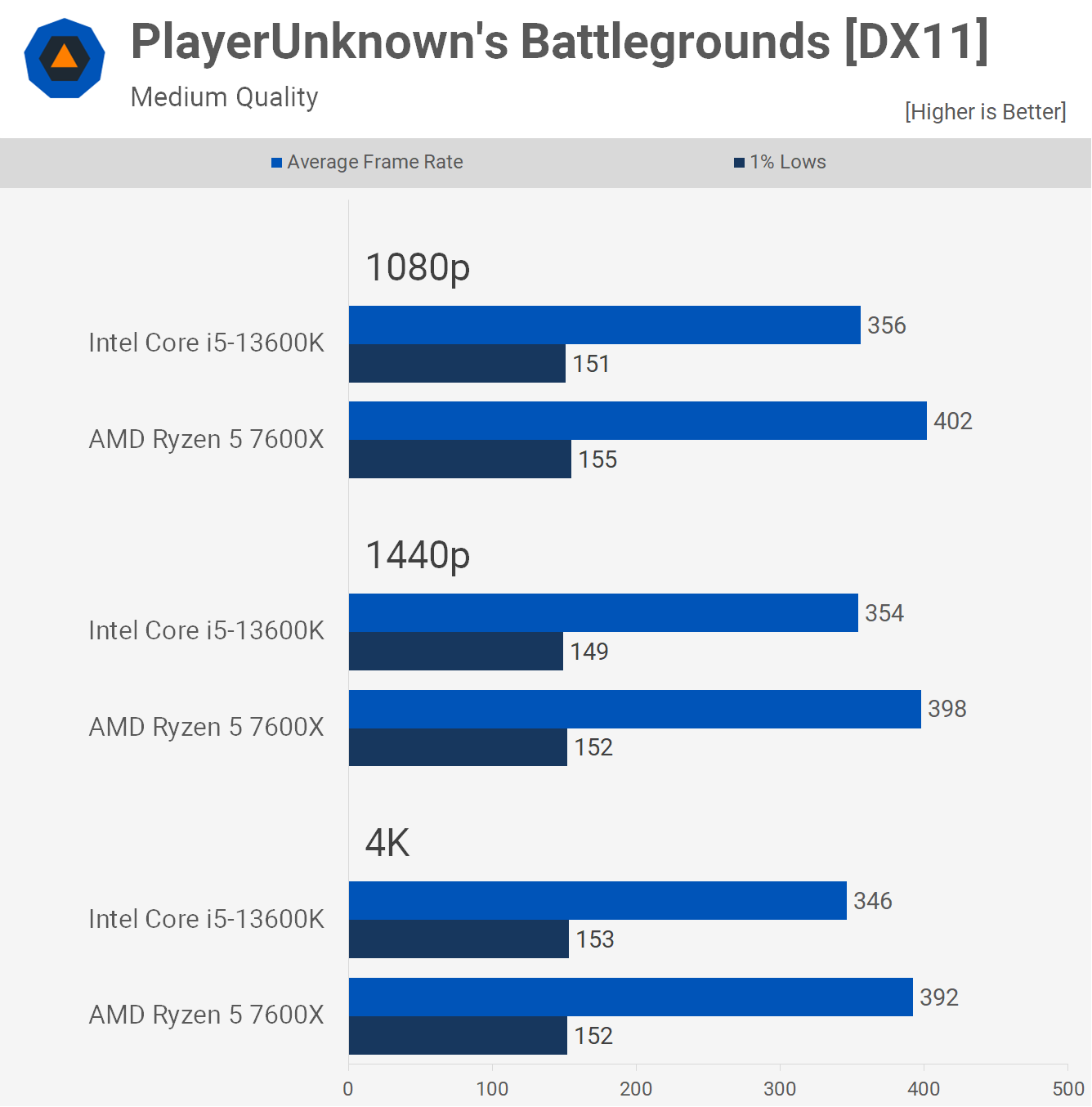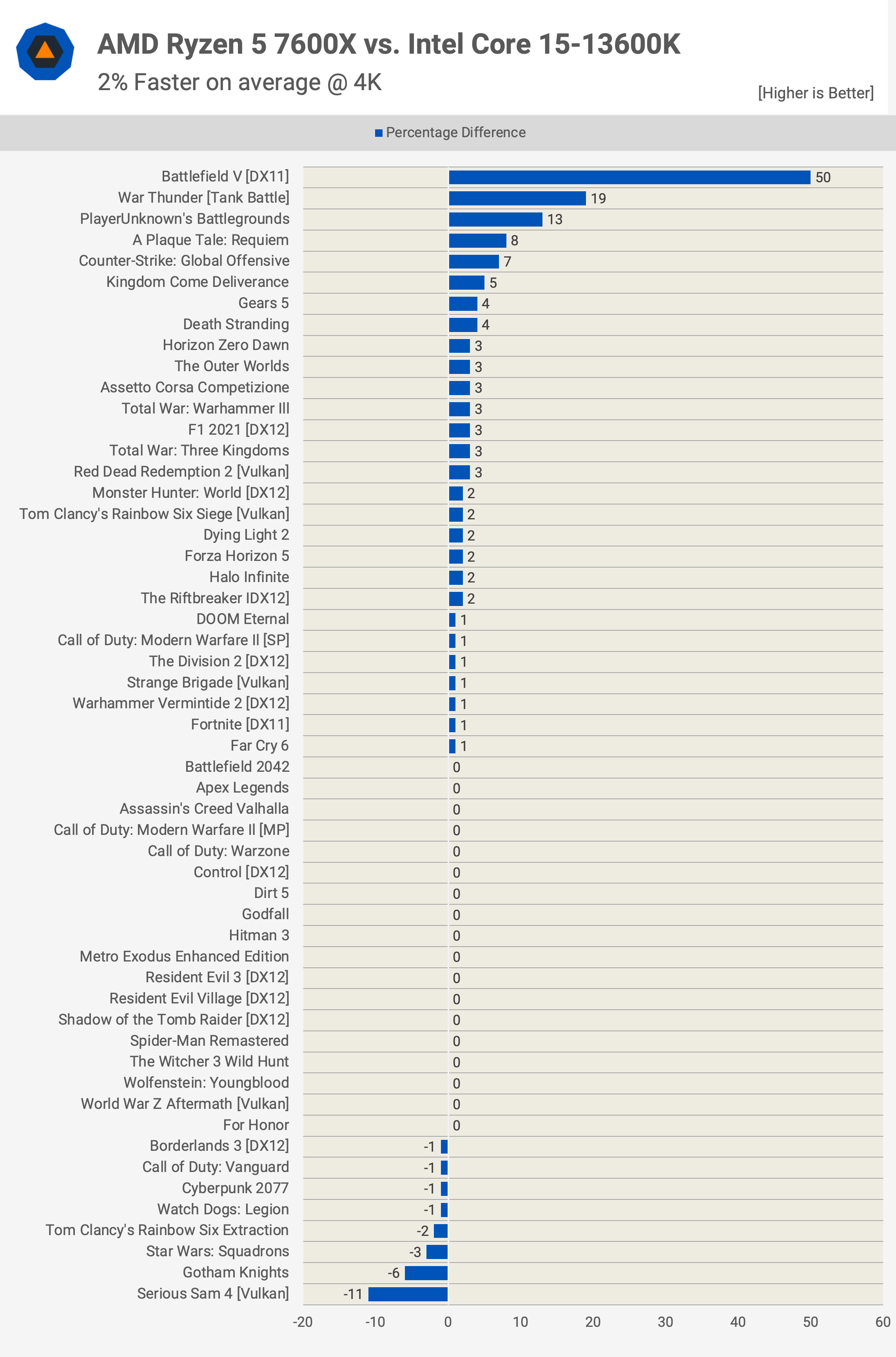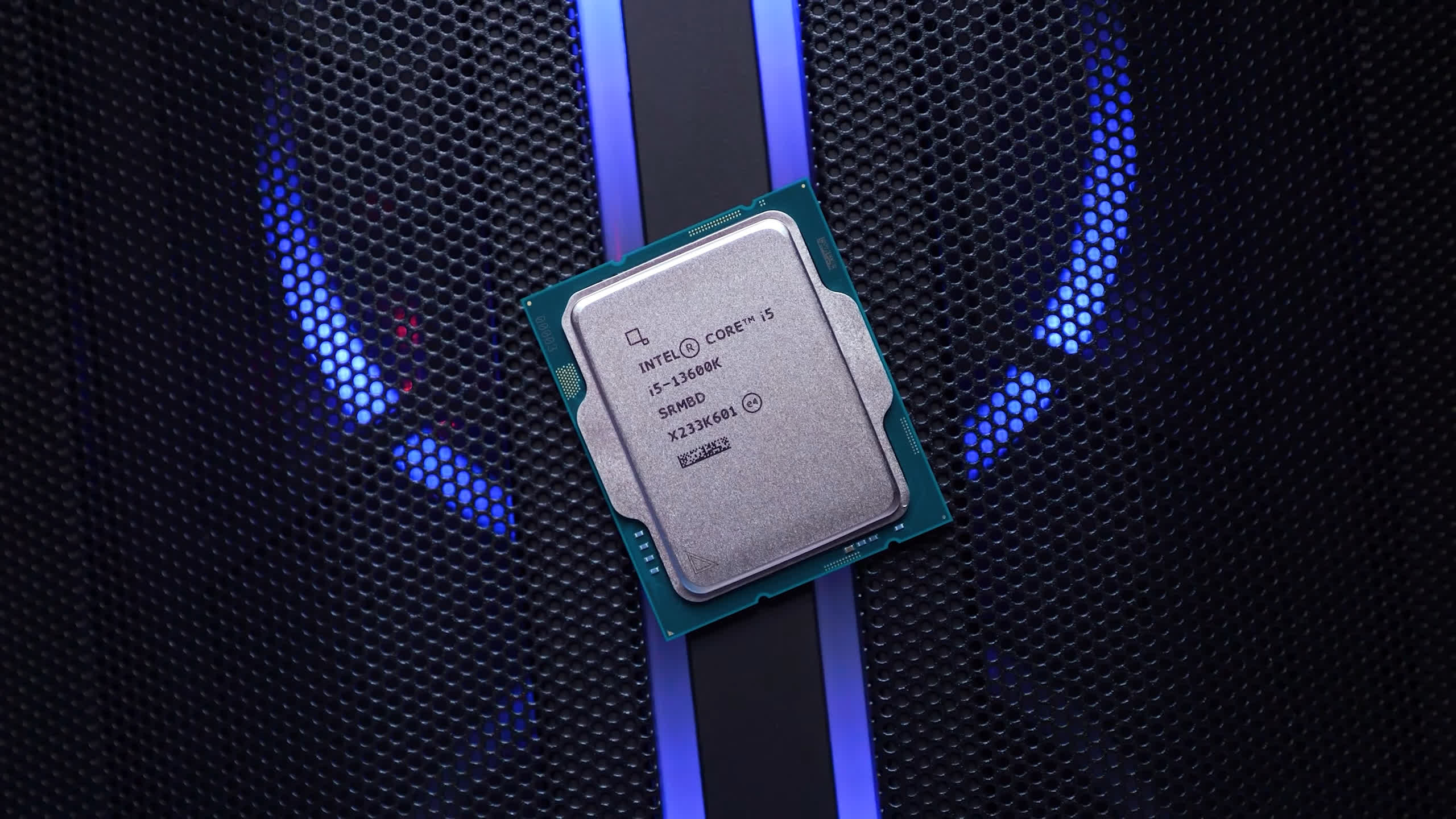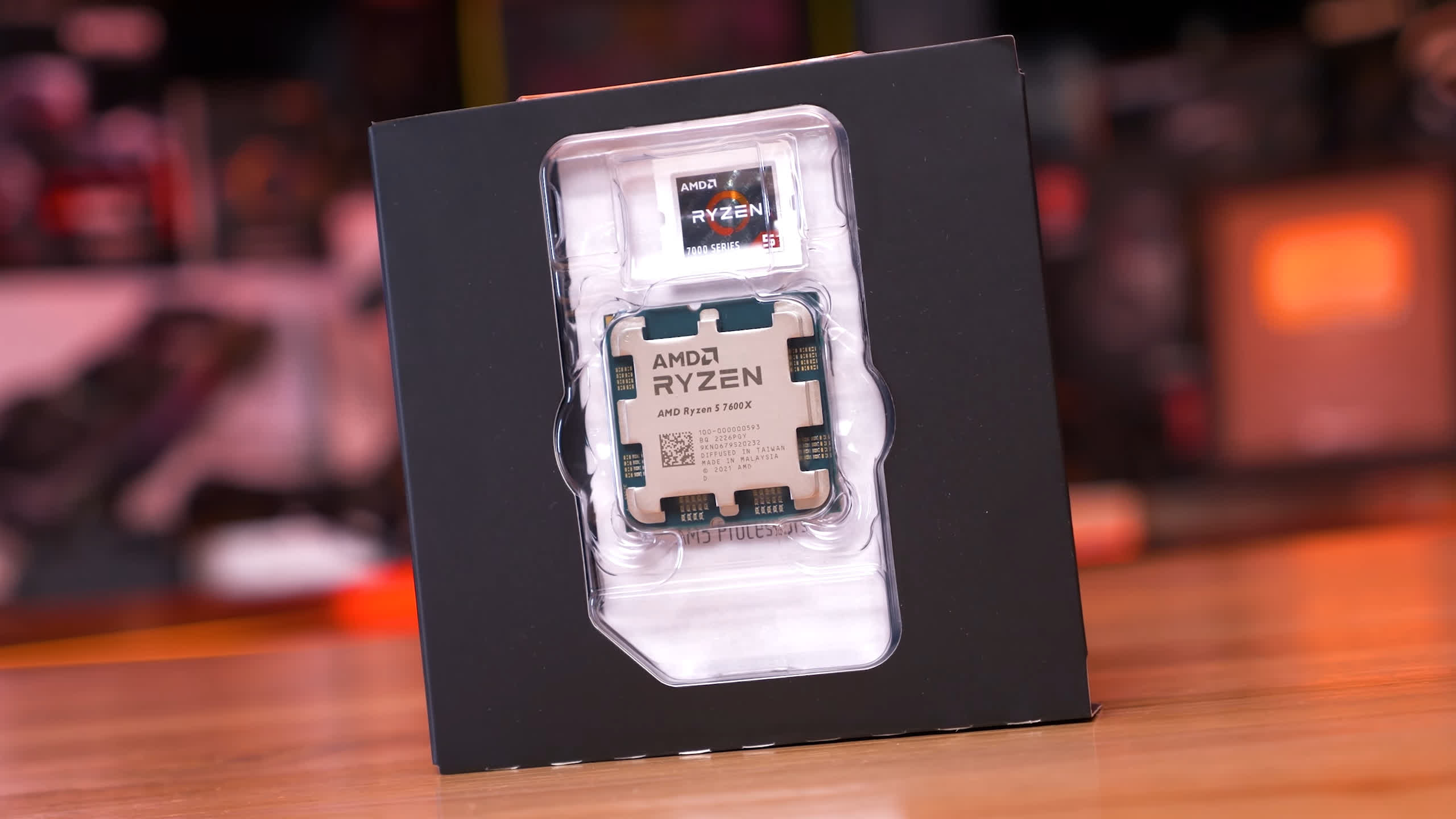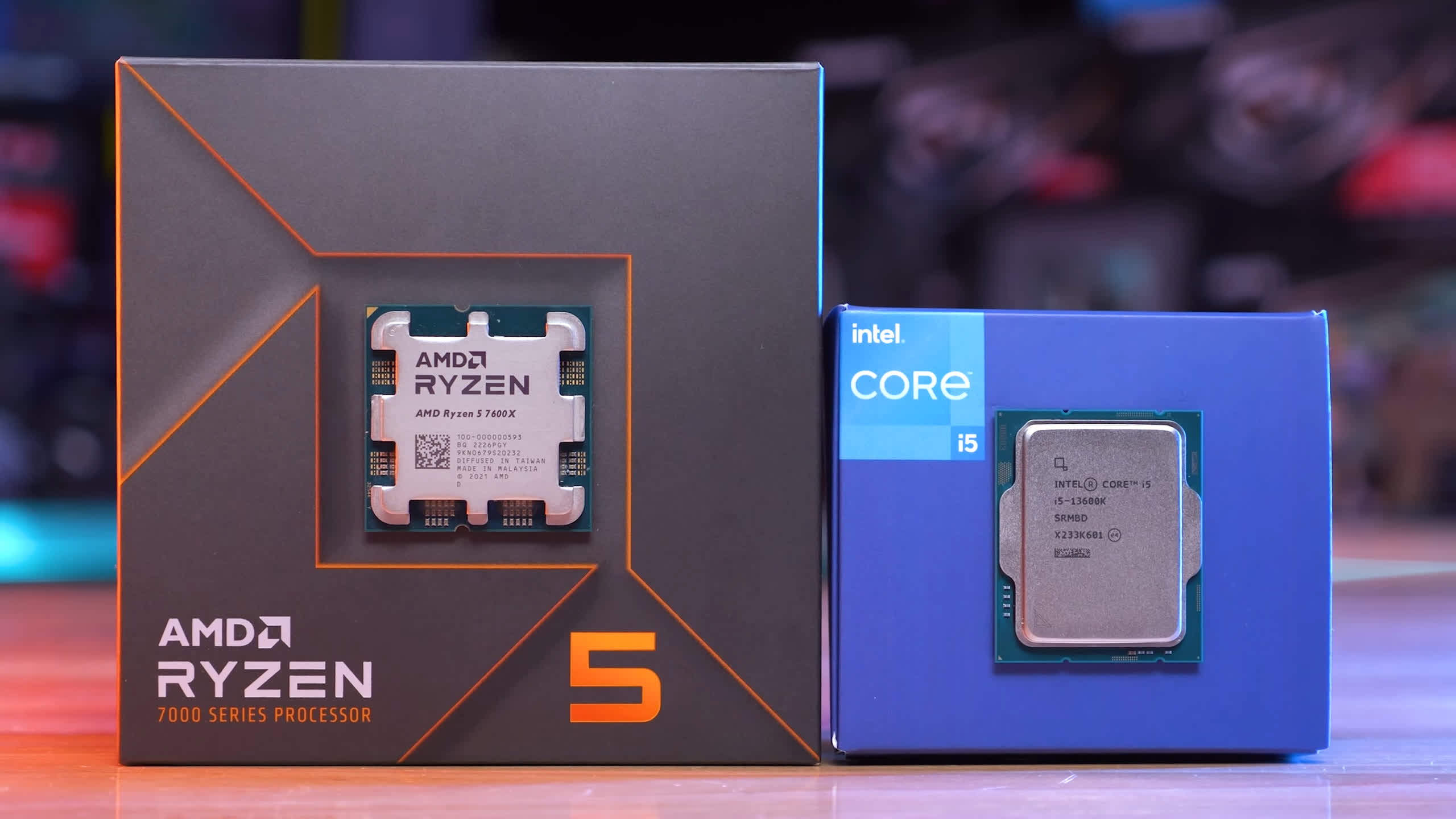Time for a massive benchmark comparison between the AMD Ryzen 5 7600X and Intel Core i5-13600K, we'll be covering 54 games across three resolutions using the GeForce RTX 4090, so that's quite a bit of data to go over.
When we reviewed these CPUs we checked them out in about a dozen games, comparing various memory and motherboard configurations to work out which offered the most value. In the end, they were very close to each other. The 13600K showed to have the advantage of stronger productivity performance, while the 7600X is more power efficient and is supported by a superior platform that should offer a significantly better upgrade path.
You can make solid arguments for going either way, but today's big benchmark comparison is more about gaming and we hope that it will make the choice easier if that's your use case.
Let's quickly go over the test system specs and then we can jump into the benchmarks. The Ryzen 5 7600X was tested on the MSI MEG X670E Ace motherboard with 32GB of DDR5-6000 CL30 single rank memory, while the Core i5-13600K was tested on the MSI Z790 Tomahawk using 32GB of DDR5-6400 CL32 single rank memory.
Please note the DDR5-6400 memory used on the Intel platform doesn't work on AM5 as it doesn't offer EXPO support and loading XMP fails to boot. So the memory has to be manually configured and that's not something most users will be willing to do. Also, to run at 6400 speeds, a Fabric frequency of 2133 MHz is required and only the best silicon will achieve this frequency while maintaining stability.
So realistically DDR5-6000 is the limit for Ryzen 7000 series processors, while 13th-gen Intel CPUs can go beyond DDR5-6400 with ease. So it's not unfair to test Intel CPUs with higher clocked memory, as they support such memory whereas Zen 4 CPUs typically don't.
The graphics card of choice is the new GeForce RTX 4090 and we're using Windows 11 and resizable bar enabled for both configurations. As we've mentioned, 54 games were tested, though we've also had to drop a few popular titles as they're no longer useful or practical for testing high-end hardware, mostly due to in-game frame caps.
Such games include God of War, Control, and Star Wars Jedi Fallen Order, all of which were maxed out even at 1440p at the game's frame limit. We also had to ditch Microsoft Flight Simulator as we've been unable to log into our copy of the game for weeks due to a server detection error (basically the Microsoft Store is rubbish and it makes testing games there very difficult, if not impossible). With that out of the way, let's get into the results...
Benchmarks
Starting with Fortnite we find similar performance between these two CPUs, interestingly though, the 13600K offered slightly higher 1% lows, around a 5% improvement, while the 7600X pushed the average frame rate up to 5% higher.
The most significant margin was seen at 4K where the 13600K produced 8% higher 1% lows. Overall not a big difference and both managed to push high frame rates in our Team Rumble late match benchmark.
Let's jump into what's probably the most confusing benchmark of this series, Battlefield V. Oddly with the 200 fps frame cap removed from both configurations, the 1% lows were fairly similar, but the average frame rate wasn't as the 7600X was 36% faster at 1080p and 56% faster at 1440p, and even more shocking we still saw a 50% margin at 4K. It looks as though we're testing two different games here, but after multiple re-tests we ended up with the same results.
We're not sure what's holding the 13600K back here, in both instances we set the frame limit to 900 fps, and triple checked the quality settings, needless to say everything was correct. It's possible this is an E-core bug, but we'll have to spend some more time looking into it.
Suggesting what we saw in Battlefield V was a bug indeed is the much newer Battlefield 2042 where the 13600K performed very well, outpacing the 7600X at both 1080p and 1440p.
Here we see that 1% lows are up to 16% greater with the Intel processor with a 7% boost to the average frame rate. By the time we reach the 4K resolution the game is GPU limited, so given we're only using the medium quality settings here for that competitive advantage, it's fair to say both processors are more than fast enough here and will almost always result in GPU limited performance.
Horizon Zero Dawn seems to prefer the Ryzen processor but unlike Battlefield V, we don't believe this is a bug, as we've seen this behavior with AMD and Intel CPUs for some time.
In this example, the 7600X delivered up to 21% greater 1% lows and 29% higher average frame rates, both seen at 1440p. Despite that the 13600K did deliver stronger 1% lows at 4K, though the average frame rate was slightly lower, so overall performance was much the same due to a GPU bottleneck.
Rainbow Six Siege also liked the 7600X for driving big frame rates, hitting 722 fps at 1080p opposed to 626 fps for the 13600K. I'm not sure that margin really matters, but 1% lows were almost 20% higher with the AMD processor.
Similar performance trends were seen at 1440p and then at 4K the game becomes heavily GPU bound, so frame rates here are basically equalized.
Moving on to Halo Infinite, the 13600K nudged ahead at 1080p by a 16% margin, hitting 213 fps, though 1% lows were only improved by 6%. Then at 1440p the Intel processor lead is reduced to 7% and then at 4K the 7600X was repeatedly a few frames faster which is odd, but this behavior was witnessed in a number of games.
Doom Eternal performance was much the same using either CPU and this is particularly true when focusing on 1% lows. Average frame rate performance was up to 5% stronger with the 13600K, but we doubt many will notice the difference between 564 fps and 595 fps.
We know a lot of you have complained about performance in Gotham Knights, but we didn't know it was this bad. Armed with an RTX 4090 we couldn't even hit 120 fps at 1080p, in fact we saw the same performance limitation at all three tested resolutions.
In short, performance sucked in this title, but the 13600K was up to 8% faster.
Forza Horizon 5 isn't too CPU demanding, but it's a 54 game benchmark, so we've included it and thought we might take a look at the data, as these results or rather margins are fairly typical of what you'll see in most games. So that is to say basically identical performance between these two CPUs.
Using the Call of Duty: Modern Warfare II multiplayer benchmark we find that the 13600K is up to 12% faster, seen when comparing 1% lows at 1080p, though there's just a 6% margin seen when comparing the average frame rate.
Those margins are significantly reduced at 1440p and then eliminated at 4K, so while the Core i5 was technically the superior performer, for the most part the margins were insignificant.
Then for the single player campaign using the ultra quality settings we see that CPU performance is virtually identical as the game is now primarily GPU limited, showing similar results to what we saw in Forza Horizon 5.
Red Dead Redemption 2 is a visually impressive single player game, though this one can be quite CPU demanding. The 7600X came out on top, delivering 6% stronger performance, but those are hardly margins to write home about, especially given we often declare margins of 5% or less to be a draw.
The last game we're going to look at the data for is PUBG and we were surprised to find the 7600X delivering stronger performance, though 1% lows were virtually identical.
Still, when looking at average frame rates we see that the 7600X wins by up to a 13% margin, which is at least noteworthy.
Performance Summary
Based on the tests above, the 7600X and 13600K appear very similar in terms of gaming performance, but we have only looked at a dozen games or so games out of the 54 titles tested, so let's jump into the comparison graphs for the full breakdown...
In our day-one review data, which is based on a 12 game sample, we had the 7600X leading the 13600K by a 3% margin. With that testing expanded to 54 games, the 7600X is 5% faster. If we remove the potentially bugged Battlefield V data (issue with the E-cores?), the 7600X was just 4% faster. Either way as we noted before, we always deem margins of 5% or less to be insignificant, or in other words a tie.
Despite using the fastest gaming GPU we can buy at a low resolution, performance overall is much the same as both the 7600X and 13600K are very fast gaming CPUs. We're talking about single-digit margins in 70+% of the games tested.
As you'd expect, the margins come down a little at 1440p and again Battlefield V is the only outlier. On average the 7600X was just 3% faster as seen in our day-one review if we remove the Battlefield V result.
Finally at 4K resolution, the 7600X was just 1% faster if we remove Battlefield V. For a little over half the games tested, the margin was 1% or less, and this data is going to be fairly representative for those of you running an RTX 3080 or slower at 1440p, though that may not necessarily apply to esports titles using low quality settings.
Power Consumption
Here's an interesting look at total system power consumption when gaming, of course, with the RTX 4090. Across the six games we looked at here, on average the 13600K consumed 14% more power than the 7600X, which doesn't sound like much and in the grand scheme of things probably isn't.
But in many instances we're talking about 60 watts or more with the bigger margins of almost 120 watts which frankly is an absurd difference. Based on this, the Ryzen 5 processor will be easier to cool, though we're not sure how relevant that is as most will strap a decent cooler on either processor anyway.
Still, even if you plan on undervolting or tuning the power usage of these processors, the 7600X is starting from a better position.
What We Learned
That was our detailed look at the gaming performance of the Ryzen 5 7600X and Core i5-13600K. Both are exceptionally capable gaming CPUs, both deliver a top-tier experience and both are worth purchasing.
The advantage of the Core i5-13600K is its superior productivity performance as it can often put those E-cores to good use, offering substantial gains over the 7600X. Also, for those of you who like to tinker with their hardware and dabble in overclocking and memory tuning, expert overclocker Buildzoid claims that the 13600K is a better choice, offering more headroom and a greater degree of memory tuning.
There's also a wider range of sub-$200 motherboards on offer, thanks to support for 600-series boards, and backwards compatibility with DDR4 means you can carry over old memory or purchase from the vast pool of already available DDR4 memory.
CPU-bound DDR4 performance will generally be slower than that of DDR5, so if you're building an entirely new PC or executing an entire platform upgrade, we do recommend jumping to DDR5 now.
The advantage of the Ryzen 5 7600X is that it's the more efficient processor, consuming less power which in theory should make it easier to cool, though we don't believe cooling to be a major consideration here. The real advantage for the Ryzen 5 part is the AM5 platform which will support at least two more generations of processors, offering a broad upgrade path for those investing now.
Ultimately, there's no right or wrong option either way you go, by default they're both excellent products, and you need to toss up between stronger productivity performance and platform longevity.
Beyond that, our only advice is that if you can wait, do so, at least until early 2023. Normally we see some interesting announcements come out of CES and we're expecting AMD will be looking to breathe some life into AM5 sales, which could mean 3D V-Cache models, improved AM5 motherboard pricing or more affordable non-X versions.
Case in point, while we were preparing this article to go live, AMD has apparently cut Zen 4 pricing across the board which is rather unexpected (or not?, see our article: AMD Ryzen 7000 is off to a slow start, Zen 4 sales are not good). It's yet unclear if these are permanent drops or just holiday deals but the Ryzen 5 7600X is now selling for $249, down from the original $299 launch price just weeks ago.
It's possible that pricing on Intel's side will become more competitive as well, and of course, DDR5 pricing is relevant there, too. So sitting on the sidelines to watch how all this plays out might be the best strategy in the short term. And of course, we'll have many more benchmarks over the coming weeks and months.
